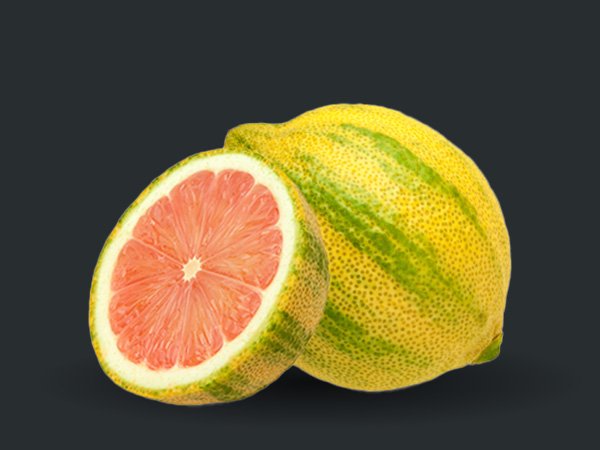Where innovation meets tradition in the world of citrus fruits
Well-Known Citrus
Valencia Oranges
-
Valencia oranges are a beloved citrus variety renowned for their sweet and tangy flavor, juiciness, and versatile culinary uses. Originating from Valencia, Spain, these oranges have become one of the most widely cultivated varieties globally for their excellent juice quality and refreshing taste.
Externally, Valencia oranges are characterized by their smooth, thin, and bright orange rind. They are typically medium to large in size, with a slightly rough texture that distinguishes them from other orange varieties. The rind is rich in essential oils, giving off a fresh and citrusy aroma when peeled.
When cut open, Valencia oranges reveal juicy, seedless segments that vary in color from pale orange to deep orange, depending on ripeness and variety. Their flesh is prized for its balanced sweetness and acidity, making it ideal for both eating fresh and juicing. Valencia oranges are particularly renowned for their high juice content, which is flavorful and refreshing.
Culinary enthusiasts value Valencia oranges for their versatility. They are enjoyed fresh as a wholesome and delicious snack, squeezed into juice for a revitalizing beverage, or incorporated into salads, desserts, and savory dishes for a burst of citrus flavor. The zest of Valencia oranges adds a fragrant citrusy aroma to baked goods, marinades, and sauces, enhancing their overall flavor profile.
In summary, Valencia oranges are cherished for their sweet and tangy flavor, juiciness, and versatility in culinary applications. Whether enjoyed fresh, juiced, or used creatively in cooking, Valencia oranges continue to be a popular choice for those seeking a flavorful and nutritious citrus fruit.
Cara Cara Navels
-
Cara Cara Navels are a delightful variation of the classic navel orange, celebrated for their unique flavor, vibrant color, and juicy sweetness. Originating from Venezuela, these oranges have gained popularity worldwide for their exceptional eating quality and distinctive characteristics.
Externally, Cara Cara Navels resemble traditional navel oranges with their smooth, thick, and bright orange rind. However, what sets them apart is their flesh, which is a striking pink to red hue due to the presence of lycopene, the same antioxidant found in tomatoes. This gives Cara Cara Navels a visually appealing aspect that stands out among other citrus fruits.
When sliced open, Cara Cara Navels reveal juicy, seedless segments that range from light pink to deep red-orange, depending on ripeness and variety. Their flesh is exceptionally sweet with a hint of tanginess, offering a delightful flavor profile that is often described as reminiscent of berries or cherries. This unique taste makes Cara Cara Navels a favorite among citrus enthusiasts and a versatile ingredient in culinary creations.
Culinary enthusiasts appreciate Cara Cara Navels for their versatility. They can be enjoyed fresh as a refreshing snack or added to fruit salads for a burst of color and sweetness. Their juice is prized for its vibrant pink hue and rich flavor, ideal for making refreshing beverages, cocktails, and desserts. The zest of Cara Cara Navels adds a fragrant citrusy aroma to baked goods, sauces, and marinades, enhancing their complexity and appeal.
In summary, Cara Cara Navels are cherished for their sweet, juicy flesh, vibrant pink color, and versatile culinary uses. Whether enjoyed fresh, juiced, or incorporated into recipes, Cara Cara Navels continue to captivate with their exceptional flavor and aesthetic appeal in both home kitchens and professional settings.
Navel Oranges
-
Navel oranges are a classic and popular variety of citrus fruit known for their sweet, juicy flavor and easy-to-peel skin. Originating from Brazil, these oranges have become widely cultivated globally for their excellent eating quality and versatility.
Externally, navel oranges are distinguished by their smooth, thick, and bright orange rind. Their shape often includes a characteristic navel or "belly button" at the blossom end, which is actually a secondary fruit that gives the variety its name. This feature makes them easy to identify among other oranges.
When peeled, navel oranges reveal tender, juicy flesh that is typically seedless and divided into segments. The flesh ranges from pale orange to deep orange, depending on ripeness and variety, and is renowned for its sweet and mildly tangy flavor profile. Navel oranges are prized for their refreshing taste, making them a favorite for snacking and juicing.
Culinary enthusiasts and chefs appreciate navel oranges for their versatility. They can be enjoyed fresh as a nutritious and delicious snack, added to fruit salads for a burst of sweetness, or juiced to make refreshing beverages and cocktails. The zest of navel oranges adds a fragrant citrusy aroma to desserts, marinades, sauces, and baked goods, enhancing their flavor profile.
In summary, navel oranges are beloved for their sweet, juicy segments, distinctive appearance, and versatility in culinary applications. Whether enjoyed fresh, juiced, or incorporated into recipes, navel oranges continue to be a popular choice for those seeking a flavorful and nutritious citrus fruit.
Lemons
-
Lemons are a quintessential citrus fruit celebrated for their bright yellow color, tangy flavor, and versatile culinary uses. Originating from Asia, particularly India and China, lemons have spread globally and become a staple in kitchens around the world.
Externally, lemons are characterized by their smooth, thin, and vibrant yellow rind, which can range from a pale lemony hue to a deep golden color. The rind is rich in essential oils, giving off a distinctively fresh and citrusy aroma. Beneath the rind lies the juicy, segmented flesh, typically pale yellow to yellow in color, bursting with tartness and acidity.
Culinary enthusiasts value lemons for their versatility. The juice of lemons is a fundamental ingredient in numerous dishes and beverages, adding a refreshing and tangy zest to salads, marinades, dressings, sauces, and cocktails. Lemon zest, grated from the rind, enhances both sweet and savory recipes with its fragrant citrus oils, making it a popular addition to desserts, pastries, and seafood dishes.
Beyond their culinary uses, lemons are also prized for their health benefits. They are rich in vitamin C, antioxidants, and other nutrients that support immune health and overall well-being. Additionally, the acidity of lemons makes them a natural cleaning agent and enhances the preservation of foods.
In summary, lemons are cherished for their vibrant color, tangy flavor, and multifaceted uses in cooking, cleaning, and health. Whether enjoyed fresh, squeezed into beverages, or used as a versatile ingredient, lemons continue to be a beloved fruit that enhances both culinary creations and daily life.
Mandarins
-
Mandarins are a beloved variety of citrus fruit known for their sweet flavor, easy-to-peel skin, and juicy segments. Originating from Southeast Asia, mandarins have become popular worldwide for their refreshing taste and convenience.
Externally, mandarins typically have a smooth, thin, and bright orange rind that peels away effortlessly, revealing tender, segmented flesh inside. Their flesh is juicy, seedless or with few seeds, and varies from pale orange to deep orange, depending on the variety. Mandarins are renowned for their sweet and mildly tangy flavor, which is often less acidic than that of other citrus fruits like oranges or lemons.
Culinary enthusiasts enjoy mandarins in a variety of ways. They are commonly eaten fresh as a quick and healthy snack, making them a favorite among children and adults alike. Mandarins are also popular for juicing, producing a sweet and refreshing beverage that can be enjoyed on its own or mixed into cocktails and smoothies. Their zest adds a fragrant citrusy aroma to desserts, salads, and savory dishes.
In summary, mandarins are cherished for their sweet, juicy segments, easy-to-peel skin, and versatile culinary uses. Whether enjoyed fresh, juiced, or used creatively in cooking, mandarins continue to be a popular choice for those seeking a delicious and nutritious citrus fruit.
Blood Oranges
-
Blood oranges are a captivating citrus fruit celebrated for their vibrant crimson flesh, which sets them apart from other oranges. Originating from Italy and Spain, these oranges boast a striking appearance with a peel that ranges from bright orange to deep red hues, hinting at the rich color within.
When sliced open, blood oranges reveal their defining feature: a deep red to maroon-colored flesh, which varies in intensity depending on the variety and ripeness. This unique pigmentation comes from anthocyanins, antioxidants more commonly found in red fruits and vegetables. Despite their dramatic appearance, blood oranges share the familiar sweet and tangy flavor profile typical of oranges, often with hints of raspberry or berry-like undertones.
Culinary enthusiasts prize blood oranges for their versatility and distinct flavor. They are enjoyed fresh as a refreshing snack or juiced to create vibrant beverages, cocktails, and desserts. The intense color of their juice makes them a popular choice for adding visual appeal to salads, sauces, and marinades, while their zest adds a fragrant citrusy essence to various dishes.
In summary, blood oranges captivate with their stunning appearance, rich color, and delightful flavor profile. Whether enjoyed fresh, juiced, or used creatively in culinary creations, blood oranges continue to be a beloved choice among citrus aficionados seeking a unique and vibrant citrus experience.
Not-So-Well-Known Citrus
Buddha's Hands
-
Buddha's Hand, also known as Fingered Citron, is a striking and exotic citrus fruit celebrated for its unique appearance and aromatic qualities. Originating from India or China, this fruit stands out with its whimsical shape and bright yellow color, resembling a cluster of elongated fingers or citron segments fused together.
Unlike conventional citrus fruits, Buddha's Hand typically lacks juicy segments or flesh inside. Instead, it consists primarily of thick, aromatic peel that is intensely fragrant and highly prized for culinary and ornamental purposes. The peel emits a sweet, floral citrus scent that enhances its appeal both in the kitchen and as a decorative item.
Culinary enthusiasts and chefs treasure Buddha's Hand for its versatility. The fragrant peel can be candied or used to infuse flavors into desserts, syrups, and liqueurs, adding a unique citrusy aroma and taste. It can also be grated or thinly sliced to garnish dishes, salads, and seafood, imparting a delightful hint of citrus without the acidity of traditional citrus fruits.
In summary, Buddha's Hand is a captivating citrus variety known for its unusual appearance, aromatic peel, and culinary versatility. Whether used for its zest in cooking or enjoyed as a fragrant centerpiece, Buddha's Hand continues to intrigue and delight with its distinctive charm and citrusy essence.
Calamondins
-
Calamondins, often referred to as Calamansi in some regions, are small, round citrus fruits that pack a punch of tangy flavor and aromatic zest. Native to Southeast Asia, these diminutive fruits measure about the size of a large cherry or small plum and feature a thin, smooth, deep orange to reddish-orange rind.
What distinguishes Calamondins is their unique flavor profile: intensely tart with a hint of sweetness, reminiscent of a cross between a mandarin orange and a lime. Their juicy, segmented flesh is typically seed-filled, adding a bit of crunch and texture to their vibrant flavor. Unlike many citrus fruits, the entire Calamondin can be eaten, including the peel, which is tender and slightly bitter, enhancing the overall taste experience.
Culinary enthusiasts and chefs value Calamondins for their versatility. They are commonly used in Filipino, Malaysian, and Southeast Asian cuisines to add a tangy kick to dishes such as sauces, marinades, and beverages. Their juice is prized for its bright acidity, ideal for making refreshing drinks, cocktails, and marmalades. The zest of Calamondins adds a fragrant citrusy aroma to desserts, salads, and seafood dishes.
In summary, Calamondins are beloved for their intense tartness, aromatic zest, and versatile culinary applications. Whether enjoyed fresh, juiced, or used creatively in cooking, Calamondins continue to enchant with their bold citrus flavor and aesthetic appeal.
Limequats
-
Limequats are a delightful citrus hybrid that blend the tangy zest of limes with the sweet essence of kumquats, creating a unique and flavorful fruit cherished by citrus aficionados. These small, round fruits typically measure about 1 to 2 inches in diameter and resemble miniature oranges with a smooth, thin, and edible rind.
When sliced open, Limequats reveal juicy segments filled with tiny seeds and a thin membrane. The flavor profile of Limequats is a harmonious balance of tartness from limes and a mild sweetness reminiscent of kumquats. The entire fruit, including the peel, offers a burst of citrusy goodness with each bite, making them a delightful snack or ingredient in various culinary creations.
Culinary enthusiasts appreciate Limequats for their versatility. They can be enjoyed fresh as a refreshing snack, sliced into salads for a zesty twist, or used to infuse beverages with their tangy flavor. Their juice and zest are also prized for adding a unique citrusy kick to marinades, dressings, jams, and desserts.
In summary, Limequats offer a delightful fusion of lime tartness and kumquat sweetness in a compact, flavorful package. Whether enjoyed fresh or used creatively in culinary dishes, Limequats continue to captivate with their unique citrus flavor and versatile appeal.
Minneola Tangelo
-
The Minneola Tangelo is a delightful hybrid citrus fruit renowned for its distinctive bell-like shape, vibrant color, and sweet-tart flavor. A cross between a grapefruit and a tangerine, this citrus gem combines the best characteristics of both parent fruits to create a uniquely delicious eating experience.
Externally, the Minneola Tangelo features a smooth, thin, bright orange-red rind that is easy to peel, revealing juicy, segmented flesh inside. The fruit is typically larger than a traditional tangerine, with a characteristic knob or "neck" at the stem end, giving it a bell-like appearance. Its flesh is deep orange to reddish-orange, juicy, and seedless, offering a perfect balance of sweetness and tanginess.
The flavor of the Minneola Tangelo is noted for its rich sweetness with a tangy citrus undertone, making it a favorite among citrus enthusiasts and culinary professionals alike. It is delicious when eaten fresh, providing a refreshing burst of citrus flavor. Its juice is also prized for its bold flavor and is often used in beverages, dressings, and desserts.
In summary, the Minneola Tangelo stands out for its unique bell shape, vibrant color, and exceptional flavor profile that marries the sweetness of tangerines with the tanginess of grapefruits. Whether enjoyed fresh, juiced, or used in cooking, the Minneola Tangelo continues to be a beloved choice for those seeking a delightful citrus experience.
Tahitian Pummelo
-
The Tahitian Pummelo is a remarkable citrus fruit known for its impressive size, sweet flavor, and tropical appeal. Originating from Southeast Asia and commonly grown in Tahiti, this fruit is the largest of all citrus species, often reaching sizes up to the size of a small melon.
Externally, the Tahitian Pummelo sports a thick, greenish-yellow rind that is easy to peel. Its flesh, when revealed, is typically pale yellow to pink, depending on ripeness, and is divided into juicy, segmented sections. Unlike other citrus fruits, the Tahitian Pummelo has a mild sweetness with subtle hints of floral and citrus notes, making it a refreshing treat on its own or as an ingredient in various culinary applications.
Culinary enthusiasts appreciate the Tahitian Pummelo for its versatility. Its sweet and juicy segments can be enjoyed fresh, added to fruit salads, or incorporated into desserts and beverages. Its zest can also be used to infuse flavors into sauces, marinades, and jams, providing a unique citrusy twist.
In summary, the Tahitian Pummelo stands out not only for its impressive size but also for its mild sweetness, versatility in culinary applications, and tropical charm. Whether enjoyed fresh or used creatively in recipes, the Tahitian Pummelo continues to be a delightful choice for citrus aficionados seeking a taste of the exotic.
Mandarinquats
-
Mandarinquats are a delightful hybrid citrus fruit that combines the sweetness of mandarins with the tangy zest of kumquats, resulting in a unique flavor profile that appeals to citrus lovers worldwide. These small, round fruits resemble miniature oranges, typically measuring about 1 to 2 inches in diameter.
The Mandarinquat's thin, smooth, and vibrant orange rind encases juicy segments that burst with a delightful blend of sweet and tart flavors. The flesh is typically seedless or contains very few seeds, enhancing the eating experience by allowing for easy consumption. Unlike other citrus fruits, the peel of Mandarinquats is tender and can be eaten along with the flesh, offering a pleasant balance of sweetness and citrusy tang.
Culinary enthusiasts and chefs appreciate Mandarinquats for their versatility in both sweet and savory dishes. They can be enjoyed fresh as a refreshing snack, tossed into salads for a burst of citrus flavor, or used to make preserves, sauces, and desserts. Their juice is also prized for its flavorful addition to beverages and cocktails.
In summary, Mandarinquats offer a delightful fusion of mandarin sweetness and kumquat tartness, making them a sought-after choice for those looking to explore unique citrus flavors. Whether enjoyed fresh or incorporated into culinary creations, Mandarinquats continue to captivate with their appealing taste and visual charm.
Centennial Kumquat
-
The Centennial Kumquat is a delightful citrus fruit known for its small size, oval shape, and vibrant orange hue. Originating from China, this variety of kumquat is cherished for its sweet and tangy flavor profile, making it a popular choice among citrus enthusiasts and chefs alike.
Measuring just a couple of inches in length, the Centennial Kumquat boasts a thin, smooth, and edible rind that offers a burst of citrusy aroma when squeezed or bitten into. Unlike other citrus fruits, the peel of the Centennial Kumquat is tender and sweet, perfectly complementing the tartness of its juicy flesh.
When enjoyed fresh, the Centennial Kumquat presents a delightful balance of sweet and sour notes, with a refreshing citrus tang that lingers on the palate. Its small size makes it convenient for snacking or incorporating into a variety of culinary creations. It can be used to add zest to salads, marinades, and desserts, or even preserved to make jams and marmalades.
Overall, the Centennial Kumquat stands out for its versatile use in both sweet and savory dishes, its appealing appearance, and its refreshing citrus flavor. Whether enjoyed fresh or used as a flavorful ingredient, it continues to be a beloved choice for those seeking a unique citrus experience.
Indio Kumquat
-
The Indio Kumquat, also known as the Meiwa Kumquat, is a delightful citrus fruit known for its small size, oval shape, and sweet-tart flavor. Originating from China and Japan, this variety of kumquat has gained popularity worldwide for its exceptional eating quality and ornamental appeal.
Externally, the Indio Kumquat features a smooth, thin, and bright orange rind that is edible and pleasantly sweet. Its oval shape is slightly larger than traditional kumquats, making it easier to handle and enjoy. When bitten into, the Indio Kumquat releases a burst of tangy juice from its thin rind, followed by a subtly sweet flesh. Unlike other citrus fruits, the entire fruit is typically eaten whole, including the peel, which adds a pleasant bitterness that enhances its complex flavor profile.
The flavor of the Indio Kumquat is noted for its balance of sweetness and tartness, making it a favorite among citrus enthusiasts. It can be enjoyed fresh as a refreshing snack or used in a variety of culinary applications. Its juice lends itself well to beverages, jams, and desserts, while its zest adds a fragrant citrusy aroma to sauces and marinades.
In summary, the Indio Kumquat offers a delightful blend of sweet and tart flavors in a compact, flavorful package. Whether enjoyed fresh or used creatively in culinary dishes, the Indio Kumquat continues to captivate with its unique citrus taste and ornamental charm.
Australian Finger Limes
-
Australian Finger Limes, often referred to as "citrus caviar," are a unique and exotic citrus fruit native to the rainforests of Australia. These elongated, finger-shaped fruits range in color from vibrant green to deep purple or crimson, depending on the variety. Their slender shape and firm, pebbly skin give them a distinctive appearance, reminiscent of small elongated cucumbers.
What truly sets Australian Finger Limes apart is their interior: when sliced open, they reveal tiny, juicy pearls that resemble caviar. These pearls come in a range of colors, such as translucent white, pink, or green, each bursting with a tangy, citrusy flavor. The texture is reminiscent of popping pearls, adding a delightful crunch and burst of juice to dishes.
Culinary enthusiasts and chefs prize Australian Finger Limes for their versatility and gourmet appeal. The pearls are often used as a garnish to elevate dishes, adding a burst of citrus flavor and a visually striking element to seafood, salads, desserts, and cocktails. They can also be used in sauces, dressings, and jams to impart a unique citrus twist.
In summary, Australian Finger Limes are a treasure trove of citrusy pearls, offering not only a burst of flavor but also a gourmet touch to culinary creations. Their unique appearance and versatility make them a prized ingredient among chefs and food enthusiasts alike, showcasing the rich diversity of Australia's native flora.
Fukushu Kumquats
-
Fukushu Kumquats, also known as Marumi Kumquatcs, are a delightful citrus fruit celebrated for their petite size, vibrant color, and exquisite balance of sweet and tart flavors. Originating from Japan, these small oval fruits boast a glossy, bright orange-yellow skin that is edible and pleasantly sweet.
When bitten into, the Fukushu Kumquat releases a burst of tangy juice from its thin, fragrant rind, followed by a subtly sweet flesh. Unlike traditional citrus fruits, the entire fruit is typically eaten whole, including the peel, which adds a pleasant bitterness that enhances its complex flavor profile.
Culinary enthusiasts appreciate Fukushu Kumquats for their versatility. They can be enjoyed fresh as a refreshing snack or used to add a unique twist to both sweet and savory dishes. Their juice lends itself well to beverages, jams, and desserts, while their zest adds a fragrant citrusy aroma to sauces and marinades.
Whether enjoyed straight from the tree or incorporated into culinary creations, Fukushu Kumquats bring a delightful burst of citrus flavor and visual appeal, making them a cherished addition to any citrus lover's garden or kitchen.
New Zealand Lemonade Lemons
-
New Zealand Lemonade Lemons are a delightful citrus variety cherished for their distinctive appearance, sweet flavor, and versatile culinary uses. Encased in a smooth, bright yellow rind, these lemons are typically larger than traditional varieties, giving them a substantial presence both on the tree and in the kitchen.
When cut open, New Zealand Lemonade Lemons reveal pale yellow flesh that is exceptionally juicy and seedless. Their flavor profile is notably sweet with subtle tartness, often likened to a blend of lemon and mandarin, making them a favorite for those who enjoy milder citrus flavors.
These lemons are ideal for a variety of culinary applications. Their juice, prized for its sweetness, adds a refreshing twist to beverages such as lemonade and cocktails. It also serves as a delightful complement to marinades, dressings, and desserts, infusing dishes with a bright, tangy essence.
Whether enjoyed freshly picked or incorporated into recipes, New Zealand Lemonade Lemons embody the perfect balance of sweetness and citrus zing, offering a unique and delightful addition to both culinary creations and aesthetic landscapes alike.
Variegated Pink Lemon
-
The Variegated Pink Lemon is a striking citrus fruit renowned for its unique appearance and delightful flavor. Its fruit stands out with a vibrant, marbled yellow and green rind, complemented by occasional stripes of pale pink blush. When sliced open, the Variegated Pink Lemon reveals translucent pink flesh, adding a whimsical touch to its visual appeal.
In addition to its captivating appearance, this lemon variety offers a distinctively tangy and slightly sweeter taste compared to traditional lemons. Its juice carries a refreshing acidity with subtle floral undertones, making it a favored choice for culinary uses such as in beverages, desserts, and as a garnish for seafood dishes.
Beyond its practical uses, the Variegated Pink Lemon is also cherished for its ornamental value, enhancing gardens with its variegated foliage and unique fruits. Whether enjoyed fresh from the tree or incorporated into various recipes, the Variegated Pink Lemon continues to captivate with its delightful blend of beauty and flavor.


















